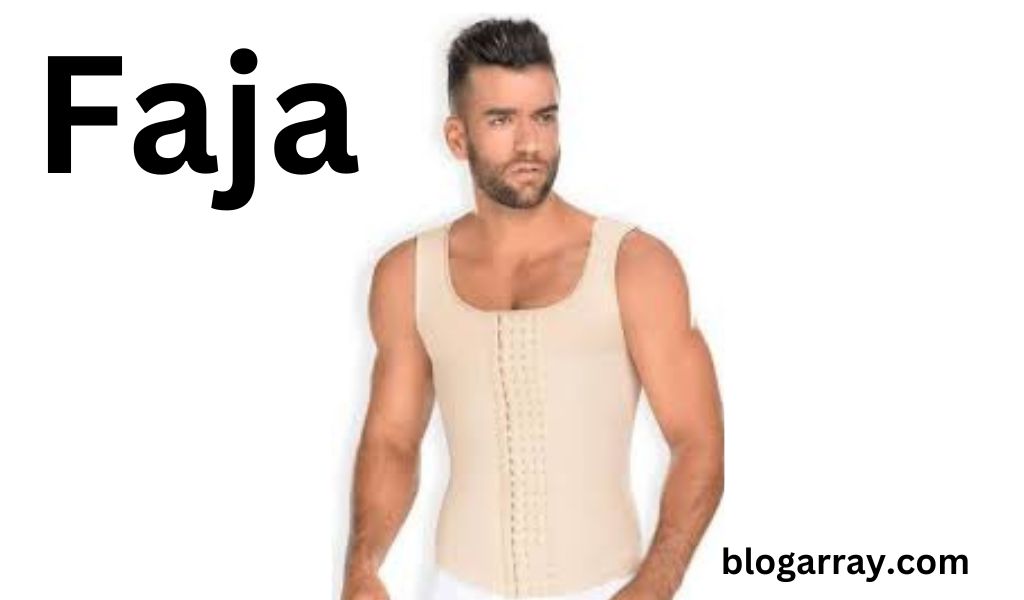The Comprehensive Guide to Faja:
Faja is a Spanish term that translates to “girdle” or “compression garment,” primarily used to describe snug-fitting garments designed to shape and support the body. These garments are especially popular in post-surgical contexts, such as after liposuction or Brazilian Butt Lift (BBL) procedures, where they help control swelling and promote healing. This is also embraced in Latin culture for body shaping, accentuating curves, and enhancing the silhouette. Its popularity has grown in English-speaking regions, particularly in the cosmetic surgery community, reflecting a blend of cultural practices and modern aesthetics
Understanding the Faja: What Is It and Its Origins
The faja, originally from Latin America, has evolved significantly over time. Historically, it was primarily used as a tool for waist training and body shaping. Today, however, its applications have broadened to include post-surgical recovery, athletic performance enhancement, and everyday wear.
History and Cultural Significance
It has deep roots in Latin American culture, where it was traditionally worn by women to achieve a curvaceous silhouette. Over the centuries, its use has expanded beyond aesthetic purposes to include medical applications, especially in aiding post-operative recovery. The cultural significance of the faja continues to be strong, with many people integrating it into their daily routines as a means of enhancing their natural curves and supporting their bodies.
Types of Fajas Available Today
Modern fajas come in various styles and compression levels, each designed for specific purposes. Some common types include:
- Post-Surgery Fajas: These provide support and compression to reduce swelling and aid in the healing process after surgeries like liposuction or tummy tucks.
- Waist Training Fajas: Used primarily for shaping and slimming the waistline, these are popular among individuals seeking a more defined silhouette.
- Everyday Fajas: Designed for daily wear, these offer light to moderate compression to enhance body shape without causing discomfort.
- Sports Fajas: These are engineered to provide support during physical activity, helping to improve posture and prevent injuries.
Understanding the different types of fajas can help you choose the one that best suits your needs, whether for medical, aesthetic, or athletic purposes.
The Benefits of Wearing a Faja
It’s offer a multitude of benefits, from immediate aesthetic improvements to long-term health advantages. Whether you’re wearing a faja for post-surgical recovery or simply to enhance your daily look, the benefits are substantial.
Immediate Shaping and Contouring
One of the most prominent benefits of wearing a faja is its ability to instantly shape and contour your body. By compressing areas like the waist, hips, and thighs, it can create a smoother, more toned appearance. This immediate transformation is particularly appealing for special occasions or when wearing form-fitting clothing.
Improved Posture and Back Support
Fajas are also known for their ability to improve posture and provide back support. The compression from the faja encourages you to maintain a straight, upright posture, which can alleviate back pain and prevent slouching. This is especially beneficial for individuals who spend long hours sitting at a desk or those recovering from back injuries.
Enhanced Confidence and Self-Esteem
The boost in confidence that comes from wearing a faja cannot be understated. By enhancing your natural curves and providing a smooth silhouette, itcan make you feel more confident in your appearance. This increased self-esteem can have a positive impact on various aspects of your life, from social interactions to professional endeavors.
Post-Surgical Benefits
For individuals recovering from surgery, particularly procedures like liposuction, tummy tucks, or C-sections, it can be an essential part of the healing process. The compression helps reduce swelling, support the surgical site, and minimize the risk of complications such as fluid retention. Additionally, itcan help the skin adhere more smoothly to the underlying tissues, promoting better results from the surgery.
Choosing the Right Faja for Your Needs
Selecting the right faja is crucial to achieving the desired results, whether for shaping, support, or post-surgical recovery. There are several factors to consider, including size, compression level, and material.
Understanding Compression Levels
It comes in different compression levels, each suited for various purposes:
- Light Compression: Ideal for everyday wear, offering a gentle shaping effect without discomfort.
- Medium Compression: Suitable for waist training and providing more defined shaping results.
- High Compression: Often used for post-surgical recovery or for individuals seeking significant waist reduction.
Choosing the correct compression level is essential to ensure comfort and effectiveness. For instance, post-surgical patients may require higher compression to support healing, while someone looking for daily wear might prefer a lighter compression.
Material Considerations
The material plays a significant role in both comfort and functionality. Common materials include:
- Lycra/Spandex: Provides flexibility and breathability, making it ideal for everyday wear.
- Powernet: A durable, high-compression fabric often used in post-surgical fajas.
- Cotton Blends: Offer comfort and moisture-wicking properties, suitable for prolonged wear.
The choice of material can impact how it feels against your skin and how well it performs, particularly in terms of compression and durability.
Sizing and Fit
Getting the right size is perhaps the most important aspect of choosing a faja. A faja that is too tight can cause discomfort and restrict movement, while one that is too loose will not provide the desired shaping or support. It’s important to measure your body accurately and consult size charts provided by manufacturers. If possible, try on different sizes to find the one that offers the best balance of comfort and compression.
How to Wear and Care for Your Faja
Proper wear and care of your faja can extend its lifespan and ensure that it continues to provide the desired benefits.
Wearing Your Faja Correctly
When putting on your faja, it’s important to do so carefully to avoid damaging the fabric or overstretching the material. Start by turning the faja inside out and stepping into it, gradually pulling it up over your body. Ensure that it is properly aligned and that there are no wrinkles or folds, which can cause discomfort and reduce its effectiveness.
Caring for Your Faja
To maintain the integrity of your faja, proper care is essential. Most fajas should be hand washed with mild detergent and air dried. Avoid using bleach or fabric softeners, as these can damage the material and reduce the faja’s elasticity. Regularly washing your faja will also help maintain hygiene and prevent skin irritation.
When to Replace Your Faja
Like all garments, fajas will eventually wear out, particularly if worn frequently. Signs that it’s time to replace your faja include loss of elasticity, fraying seams, or if the faja no longer provides the desired level of compression. Regularly inspecting your faja for these signs can help ensure that you’re always getting the best performance.
Faja for Post-Surgery: A Crucial Part of Recovery
For those undergoing surgery, particularly cosmetic procedures like liposuction or abdominoplasty, the faja is more than just shapewear—it’s a critical tool in the recovery process.
Why Post-Surgery Fajas Are Important
Post-surgery fajas provide the necessary compression to help control swelling, improve blood circulation, and support the skin as it heals and reattaches to the underlying tissues. The consistent pressure from the faja helps reduce the risk of fluid retention, which can cause complications and delay recovery.
Selecting the Best Post-Surgery Faja
When choosing a faja for post-surgery recovery, it’s important to consider the level of compression needed, the areas of the body that require support, and the ease of wear. Some post-surgery fajas come with adjustable straps or zippers to make them easier to put on and take off, which can be particularly helpful when mobility is limited.
Tips for Wearing a Faja After Surgery
After surgery, it’s essential to follow your surgeon’s instructions regarding when and how to wear your faja. Typically, patients are advised to wear the faja 24/7 for the first few weeks, only removing it for short periods to shower. As healing progresses, the duration of wear can be gradually reduced.
Managing Discomfort and Skin Care
Wearing a faja after surgery can sometimes cause discomfort. Particularly if the skin is sensitive or if there are areas of swelling. To manage discomfort, ensure that the faja is properly fitted and avoid overly tight garments. Additionally, keeping the skin clean and moisturized can help prevent irritation.
The Psychological Impact of Wearing a Faja
Beyond the physical benefits, wearing a faja can have a profound psychological impact, particularly in terms of self-esteem and body image.
Boosting Confidence and Self-Esteem
For many individuals, wearing a faja provides an instant boost in confidence. The enhanced silhouette and improved posture can make you feel more attractive and self-assured, which can positively influence your interactions with others.
The Role of Fajas in Body Image Perception
Body image is a complex issue, and for some, wearing a faja can help bridge the gap between their ideal and actual body shape
Also Read: Flower Boutonnieres: Timeless Accents for Your Big Day
FAQs
What is a faja, and how does it work?
A faja is a type of compression garment traditionally used for body shaping and post-surgery recovery. It works by applying pressure to specific areas of the body, such as the waist, hips, and thighs, to create a smoother silhouette, support healing, and improve posture.
Can wearing a faja help with weight loss?
While a faja can help you look slimmer by compressing your midsection, it doesn’t directly cause weight loss. However, some people find that wearing a faja. That encourages them to maintain better posture and engage in a healthier lifestyle, which can contribute to weight management over time.
How long should I wear a faja after surgery?
The duration for wearing a faja after surgery varies depending on the procedure and your surgeon’s recommendations. Generally, patients are advised to wear a faja for at least six weeks post-surgery, with continuous wear during the first few weeks and gradually reducing use as healing progresses.
Is it safe to wear a faja every day?
Yes, it is generally safe to wear a faja every day, as long as it’s properly fitted and not too tight. Daily wear fajas are designed for comfort and can be worn for extended periods without causing harm. However it’s important to listen to your body and ensure the faja is not causing any discomfort or restricting your movement.
How do I choose the right size faja?
Choosing the right size faja involves measuring your waist, hips, and other relevant body parts according to the manufacturer’s size chart. It’s crucial to avoid choosing a size too small, as this can lead to discomfort and restrict breathing or circulation. If you’re between sizes, it’s often better to size up for comfort.
Can men wear fajas?
Absolutely! Fajas are not exclusive to women; many men wear them for body shaping, posture support, and post-surgery recovery. There are fajas specifically designed for men. Which target areas like the abdomen and back, providing similar benefits as those designed for women.













